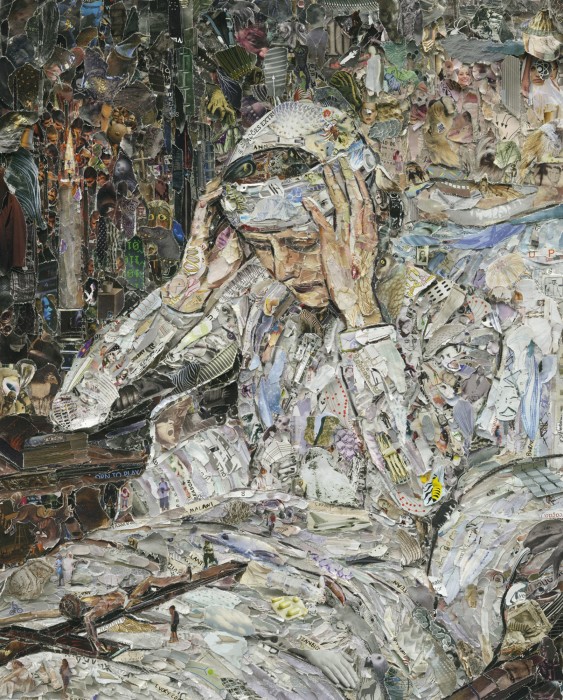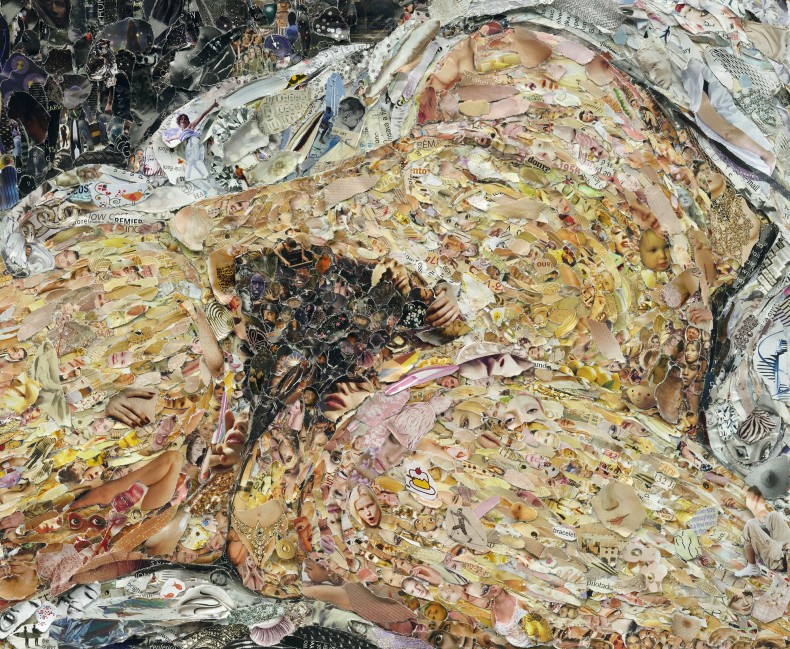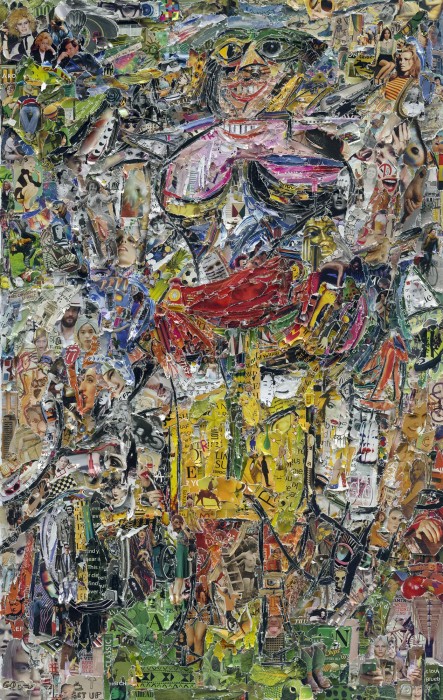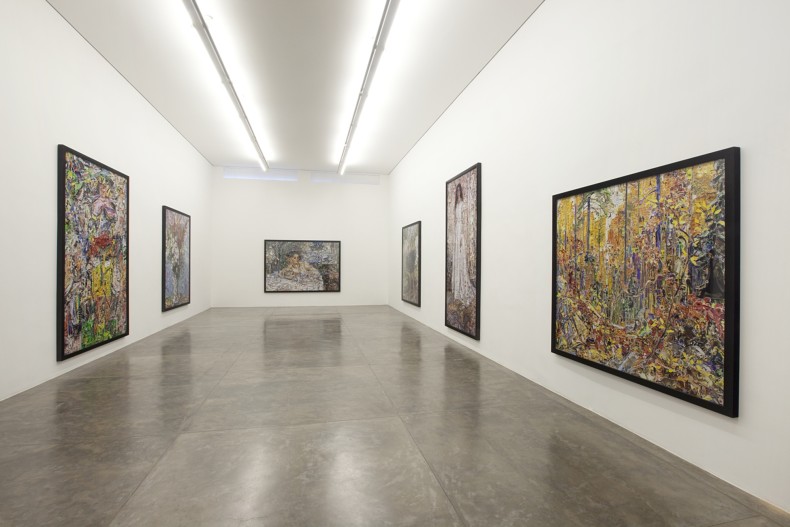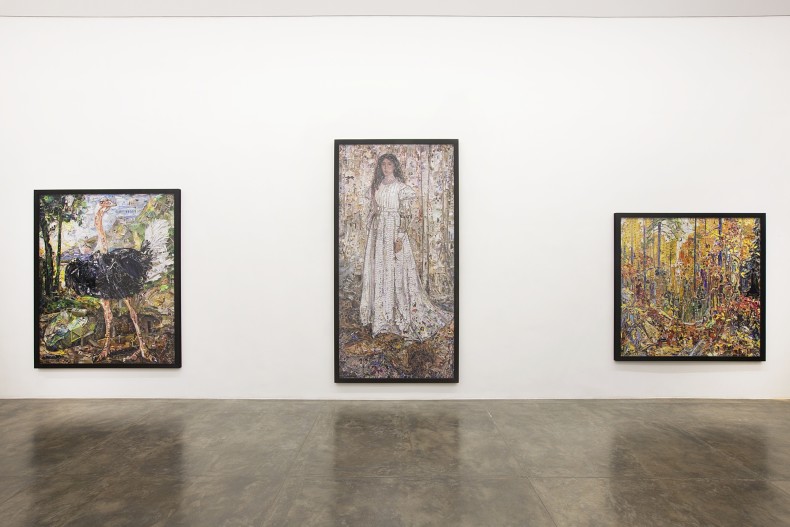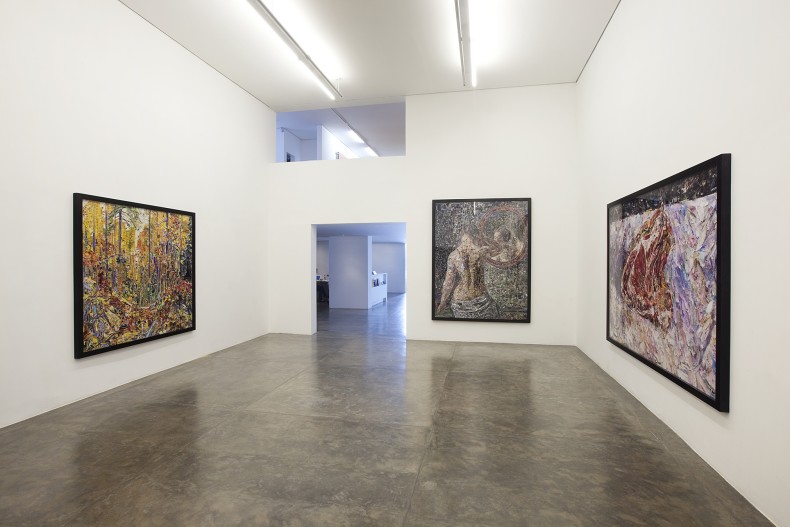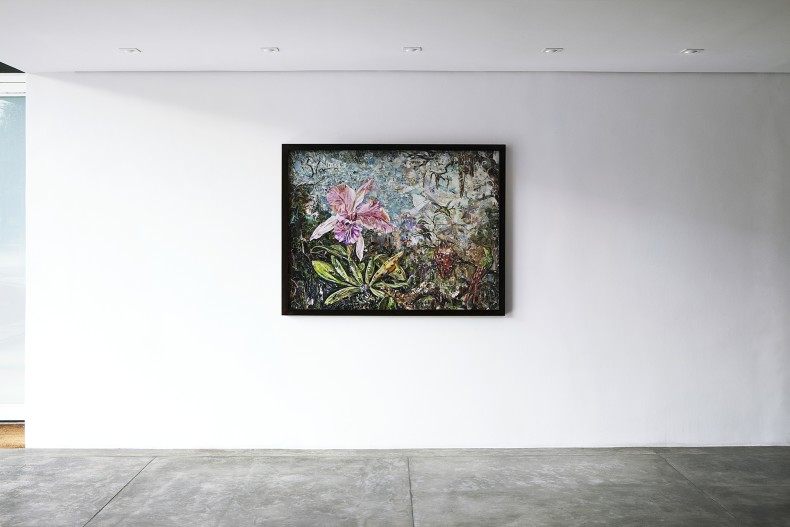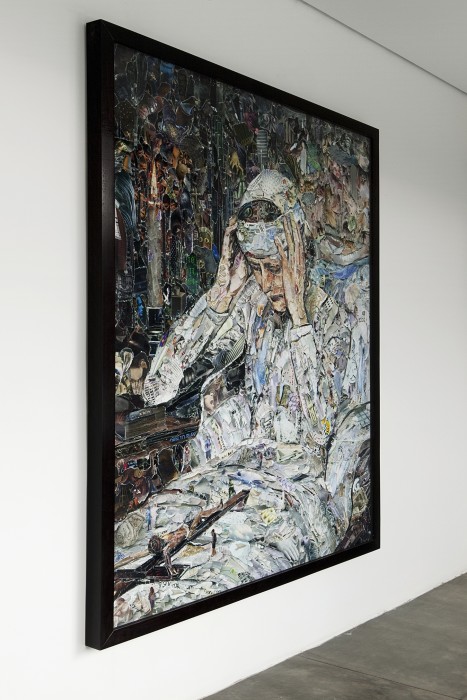Vik Muniz’s latest series of large-scale photographs deliberately evoke a double take. At first glance they look familiar, a gallery of stolen, famous images: Courbet’s Origin of the World, Monet’s Vase of Flowers, Caillebotte’s Rib of Beef, Whistler’s Symphony in White. But, on closer inspection, they are not quite what they seem. Each picture is a collage composed from hundreds of images culled from magazines devoted to topics as varied as motor sports to guns, artfully arranged according to colour gradient. This giddy mosaic of overlaid imagery, which dissolves the picture plane into a multiplicity of focal points, has been scanned and enlarged so that you can see the hairs, the fibers, even the cellulose of the torn-edged paper. Lit from a single source, so as to imitate the natural light of a picture on a wall, they look almost three-dimensional. Photography acts like a kind of glue, revealing a dense, rag-patch quilt of media imagery.
“They have to be ripped so they look more accidental,” Muniz explains of his collage technique, “as if they just fell there like confetti.” Muniz once had aspirations to be a psychologist and is interested in Gestalt theories of vision, pattern recognition and completion. The artist’s work has long explored the idea of the deliberate accident – or, as Duchamp put it, “canned chance” - playing on the tension between contingency and intention, in how the eye and brain work together to, as Muniz calls it, create ‘multi-stable images’. He has conjured up, for example, the Medusa’s head in a postprandial plate of spaghetti, and other seemingly miraculous, iconic images in chocolate syrup, diamonds, sugar and caviar, where they manifest, as if by chance, like the stained outline of Jesus’s face on Veronica’s veil. In so doing he hopes to bring tired, well-known paintings and exhausted poster store iconography (Chaplin, Guevara, Monroe) back from the dead.
In his collages, Muniz acknowledges the influence of 1960s rom affichistes, artists who ripped off bits of posters to reveal other imagery hidden underneath in their ragged, subtractive dé-collages; or Fluxus artists like Al Hansen, who reconstructed icons such as the Venus of Willendorf in waste matter, including cigarette butts and coke cans. His own work has long explored such contrasts of low and high culture, of the can and canon. Indeed, Pictures from Magazines 2, Muniz says, was inspired by his work in Jardim Gramacho, Rio de Janeiro’s largest rubbish dump, where in 2010 he collaborated with the catadores on enormous, classical portraits created from the debris amongst which they worked (the subject of the Oscar-nominated film, Waste Land).
“When you’re in Gramacho,” Muniz explains, “you’re surrounded by something that’s between object and substance. Garbage hasn’t yet turned back into nature yet, it still has fragmentary bits of usefulness, things that you can identify, but it’s very confusing and tiring to look at because your attention is constantly diverted somewhere else.” Muniz draws a parallel with the saturated world of images in which we live; one scans the exhausting overload of pictures in a magazine with subliminal attention before affixing on something of interest, much as a garbage collector scours the dump. “The feeling of it all in your memory is similar to the junk,” he says. “Making a picture with all that crap is very symptomatic of the way we look at everything today, full of distractions.”
In the contrasting, pristine environment of the museum, Muniz once noticed that visitors were queuing to look at the paintings from a privileged viewpoint. From this distance they could just sense the picture frame, allowing the subject of the composition to fill their visual field, while allowing their eye to go inside it so as to explore the materiality of the surface, where the painting breaks down into an earthy mess of oil and pigment. He observed that viewers sometimes moved backwards and forwards, rocking in a kind of trance as they explored this magical border between concept and matter. It is this crossing point, Muniz contends of the encounter, that is the sublime in art: “These are the moments,” he has said,” that contain in their transcendence, the very nature of representation.”
In his large-scale photographs, Muniz seeks to extend that moment of sublimity. The multiplicity of imagery used to compose his collages adds a mediating, third layer that further ensnares the viewer and makes reference to all the cultural and visual baggage they bring to their encounter with art. The individual pieces that make up the overall jigsaw are pictures in themselves that draw in and slow down the movement of the eye, frustrating any smooth reading. It is hard to resist the search for meaning, but Muniz tries to resist whimsical juxtapositions, preferring a maze of surreal non-sequitors: “a picture of a giraffe next to a firefighter next to a toaster - the crazier and more stupid the better” (this suggests Lautréamont’s definition of the beautiful “as the chance encounter of a sewing machine and an umbrella on an operating table). Everything is left deliberately ambiguous, so as to offer only the minimal amount of security to the viewer whilst capturing them in a maze of confusing possibility: “I try to avoid any kind of closure,” Muniz says, “The moment you find closure in a picture your motion is to pull away from it.”
Muniz has a scholarly interest in optical illusions and jokes. “I explore both in my work,” he says, “and take them very seriously”. Much as scientist looks at optical illusions to show how vision works by exploring the moments in which it breaks down, he elaborates, linguists look at humor to understand language. At the climax of a joke, the rickety structure that has been conjured up in the mind of the listener suddenly collapses. “At that particular moment you laugh and, momentarily, you’re free,” Muniz explains. “It’s that moment I want to capture in my art – the moment where you have to deal with things yourself – and you have to allow a lot of ambiguity to let that happen… In a way I want my art to work as a machine that facilitates that happening. I’m the watchmaker, working in the back, manipulating the gears in a certain way.”

